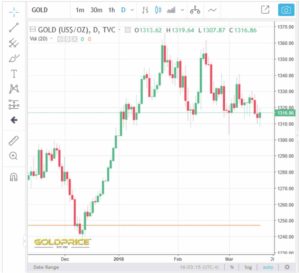The performance of gold over the past 6 months has been rather lacklustre. Between October 2017 and March 2018, the gold price has not appreciated. However, over 16 years the price of gold is up 349.31%. The average annual gold price performance since 2003 in USD is 9.8%, and in GBP is 11.3%. Clearly, gold is keeping pace with inflation, and generating returns in the process. The ever changing gold price is particularly susceptible to geopolitical events however.
Whenever uncertainty enters the financial markets, investors and traders typically flock to gold as a safe-haven asset. Recently Russian president Vladimir Putin was re-elected in what stooges labelled a landslide victory. This ‘negative’ news sent the price of gold to a fresh 3-month low. However, there is additional uncertainty in the financial markets.
The price of gold is heavily influenced by the strength of the USD. When the Fed moves to increase interest rates, gold bears the brunt. Since gold is not an interest-bearing asset, it cannot keep pace with rising interest rates. The USD benefits from the FOMC decision to increase interest rates. Before the rate hike vote on Wednesday, 21 March 2018, pundits were expecting the interest rate to rise by 25 basis points in the region of 1.50% – 1.75%.
Rising Interest Rates Muddy the Waters for USD and Gold Bugs
Leading into the FOMC decision, there was a 94.4% likelihood of interest rates rising by 25-basis points. These types of macroeconomic data releases do not bode well for the price of gold. As a dollar-denominated asset, gold is typically associated with lower levels of demand when the USD appreciates. Gold costs more in foreign currency when the USD strengthens, driving down demand among foreign buyers.
Other geopolitical tensions continue to dominate the scene, notably the souring of relations between the UK and Russia over the Kremlin’s poisoning of a Russian official in the UK. Every time there is good news, the price of gold falls, and every time there is bad news the price of gold tends to rise.
It was recently reported that a Brexit transition deal is in the works, and this would smooth over the UK’s extrication from the EU ahead of the March 2019 deadline. Such details send the GBP higher and depress the gold price. According to the latest reports, the UK would be able to maintain parts of its relationship with the EU through December 2020.
Mixed Indicators Give No Clear Direction to Gold
Much of what we are seeing in the financial markets is based on speculative sentiment. When the pundits place a high probability of a rate hike on the table, speculators actions move accordingly. Many of the bigger hedge funds are expecting the Fed to continue its policy of interest rate hikes, downgrading the performance of gold stocks and ETFs. For the most part, there appears to be a net bearish position on gold over the short to medium-term. This information is regularly released by the Commodity Futures Trading Commission (CFTC).
The US dollar index is surprisingly bearish given the trend of rising interest rates. The 52-week trading range of the US dollar index is 88.25 on the low end and 101.34 on the high-end. At the time of writing, it was a smidgen above the 52-week low at 89.90. The US dollar index is an important barometer of the strength/weakness of the USD against a basket of currencies. This particular measure has depreciated by 10.43% over 1 year, and is down 2.42% for the year to date. Dollar weakness typically bodes well for the gold price, since foreign buyers can purchase more bullion for their money when the USD is performing poorly.



{ 0 comments… add one now }